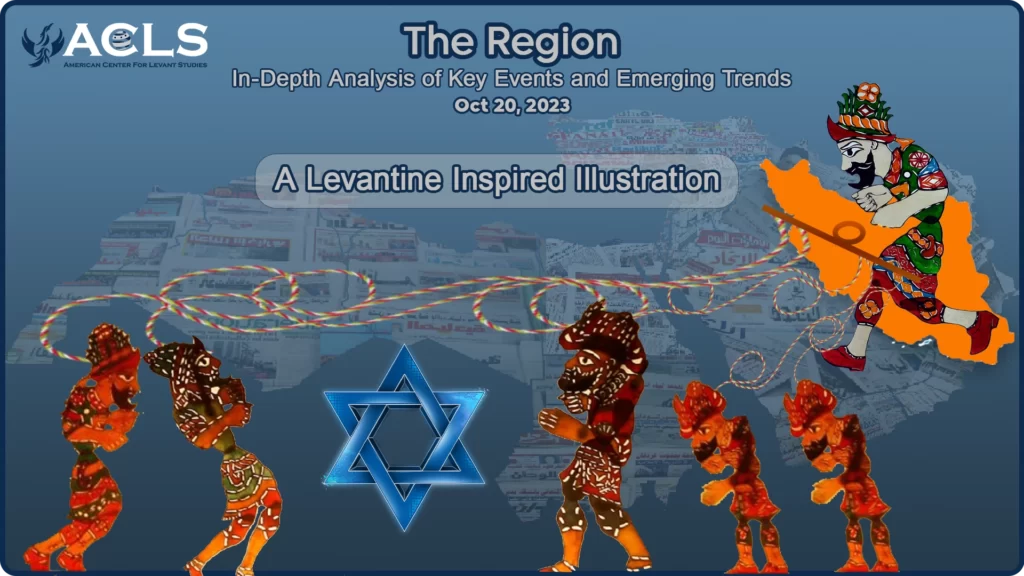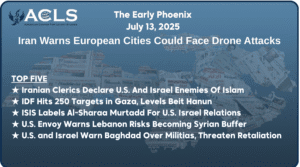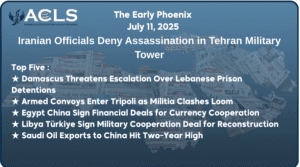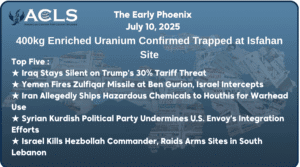
By: Rania Kisar
Headlines:
- Latest Update on the Israel-Hamas Battleground: IDF and Hamas Escalate Operations.
- Galaxy Leader Hijacking: Divergent Views on Houthi Rebels’ Bold Move.
- King Abdullah II’s Gaza Strategy: A Need for Strategic Revision?
- Haaretz Report on Israeli Helicopter Incident Causes Uproar.
- Interpreting Khamenei’s Threats: Calculated Moves in Regional Power Play.
- Hezbollah-Israel Situation Report.
=====================
- Latest Update on the Israel-Hamas Battleground: IDF and Hamas Escalate Operations
GAZA CITY, November 20, 2023 – The Al-Qassam Brigades, Hamas’s military wing, claimed responsibility for killing [six] Israeli soldiers in close combat in the Juhr al-Dik area. Employing anti-personnel missiles and machine guns, the militants engaged the IDF forces, as stated in a release by the group. However, the IDF confirmed five fatalities, adding to the toll of 58 officers and soldiers reportedly killed since the onset of the so- called Operation Al-Aqsa Flood on October 27, 2023.
In a separate incident, IDF airstrikes targeted senior Hamas officials in the northern Gaza Strip, resulting in the death of Ahmed Behar, a prominent figure within the organization. This operation signifies a loss of control for Hamas in the northern regions.
Simultaneously, IDF units conducted precise raids in Gaza’s upscale Rimal neighborhood, known to house many top Hamas commanders. These operations led to the discovery of numerous tunnel shafts, seizure of a variety of weapons, and neutralization of several combatants.
Due to these developments, Lt. Gen. Herzi Halevi, Israel’s Chief of Staff, approved the continuation of ground operations against Hamas. The IDF has presented new evidence suggesting that Al Shifa Hospital in the Gaza Strip was used as a terror base, where Hamas terrorists took hostages on October 7. Surveillance footage shows Hamas terrorists inside the hospital forcibly taking hostages who were kidnapped from Israeli territory. Additionally, IDF forces uncovered a 55-meter-long terror tunnel underneath the hospital complex, equipped with defensive measures.
The IDF is escalating its search for key Hamas leaders Yahya Sinwar and Mohammed Deif in the Gaza Strip, amid indications from Prime Minister Benjamin Netanyahu that the Palestinian Authority’s control over Gaza may not be restored post-conflict. In related news, former Israeli Prime Minister Ehud Olmert, in a Euronews interview, stated that Hamas’s actual headquarters is in Khan Yunis, not Al-Shifa Hospital. Olmert advocated for Israel to pursue a two-state solution with the Palestinian Authority, which would include Gaza in a future Palestinian state.
=====================
- Galaxy Leader Hijacking: Divergent Views on Houthi Rebels’ Bold Move.
The recent hijacking of the ‘Galaxy Leader’ by Houthi rebels in the Red Sea, a cargo ship owned by a British company and operated under a Japanese flag, marks a significant escalation in regional tensions. This audacious act, aligned with the Houthis’ threats against Israeli or Israeli-affiliated vessels. Despite Israeli Defence Forces confirming no Israeli citizens were onboard, the incident has sparked international alarm, raising the stakes for maritime security in a critical global shipping lane. The Houthi group’s claim of responsibility, framing it as a retaliatory act against perceived Israeli aggression, were reported to have used a helicopter to seize a Japanese cargo ship in the southern Red Sea.
In an Al Arabiya TV interview, contrasting views on the ‘Galaxy Leader’ incident were discussed. Dr. Hossein Royoran, a Tehran political science professor, denied Iranian involvement, attributing the attack to Houthi rebels reacting to Gaza’s crisis. He criticized the global community’s stance on arms support, seeing the seizure as a warning to Israel and the U.S., not an escalation sign. Jonathan Gilliam, a New York-based expert, argued Iran’s indirect involvement through Houthi support, suggesting broader conflict intentions. Royoran, on the other hand, cited Q88.com records affirming the ship’s Israeli ownership, declaring it ‘legitimate targets’. Gilliam concluded the discussion by assuring the audience of the United States’ resolve to prevent such incidents in the future. Referring to the ongoing conflict in Gaza and the uncertainties surrounding it, he suggested that continued aggression in the Red Sea might prompt direct U.S. military action against Iran, termed as the ‘Head of the Snake.’
=====================
- King Abdullah II’s Strategy in Gaza: A Need for Strategic Revision?
As the Gaza conflict intensifies, King Abdullah II of Jordan finds himself navigating a complex geopolitical landscape. Recent statements from the King and Queen of Jordan indicate a public stance against Israel, a position that appears increasingly precarious given the multifaceted challenges Jordan faces.
In a recent development, King Abdullah II vowed to respond to what he termed an Israeli “attack” on a Jordanian field hospital in Gaza, labeling it a “heinous crime.” This incident has escalated tensions, with the King underscoring the need for a ceasefire and the protection of civilians in Gaza. His condemnation aligns with Jordan’s historical support for the Palestinian cause, yet it also reflects the delicate balance Jordan must maintain in its regional relations.
Concurrently, Jordan grapples with the threat of growing extremism within its borders, exacerbated by the ongoing Gaza conflict. The nation’s geographic vulnerability heightens concerns over the potential influx of displaced Palestinians and elements from the “Axis of Resistance,” including Houthi forces in Yemen. This complex security situation poses a significant challenge for King Abdullah and Foreign Minister Ayman Safadi, who have been engaged in diplomatic efforts to quell hostilities while emphasizing civilian protection and humanitarian aid facilitation.
It appears that King Abdullah, while cautious about extremist elements entering Jordan, may not fully acknowledge the strategic implications of Israel’s actions in Gaza. From one perspective, Israel’s military efforts could be seen as a bulwark against the broader threat posed by Iran and its proxies, potentially safeguarding Jordan’s stability, including the Hashemite clan’s position. This nuanced situation underscores the intricate balancing act King Abdullah faces: addressing immediate humanitarian concerns in Gaza while considering long-term regional stability and the role of Israeli actions in this broader geopolitical context.
Additionally, the postponement of a significant energy-for-water agreement with Israel amid the conflict and Queen Rania’s vocal support for the Palestinians signal a shift in Jordan’s diplomatic posture. However, these actions must be weighed against the potential risks, including the internal and external repercussions of a hardline stance against Israel.
In summary, King Abdullah’s strategy in response to the Gaza conflict and his public position against Israel illustrate the complexities of Jordan’s geopolitical situation. While aligning with the Palestinian cause and condemning Israeli actions, Jordan must also consider the broader regional security dynamics, including the threats posed by extremist groups and the influence of Iranian-backed forces.
=====================
- Haaretz Report Sparks Regional Controversy.
Haaretz’s report on an Israeli helicopter firing at a festival near Kibbutz “Ra’im” during the October 7 massacre operations has stirred significant controversy. The article, which quickly went viral, suggests that the Israeli military may have mistakenly targeted a concert, potentially involving Hamas fighters, leading to 364 deaths. Prime Minister Netanyahu and Opposition Leader Yair Lapid, have strongly refuted the Palestinian Authority’s claims that the Israel Defense Forces (IDF) intentionally caused these deaths. Israeli authorities have emphasized the lack of evidence supporting any deliberate civilian targeting in this incident.
=====================
Iran
- Interpreting Khamenei’s Threats: Calculated Moves in Regional Power Play.
Ayatollah Khamenei, Iran’s Supreme Leader, aims to remain central in the diplomatic and military posturing of the region’s affairs. Khamenei’s directive for Islamic nations to temporarily sever ties with Israel, while showcasing the IRGC’s Aerospace achievements, deserves thorough dissection. Khamenei’s deftly calculated messages should serve as a striking reminder that a peaceful or diplomatic solution may be futile in American efforts and could further endanger Israel and American forces in the region.
Khamenei chose to deliver his message during the unveiling of the Fattah 2 missile at the IRGC Aerospace Force exhibition, a significant technological leap. The introduction of hypersonic glide vehicle (HGV) technology, capable of reaching speeds from Mach 5 to 20 and altering its trajectory post-launch, poses a formidable challenge to existing air defense systems. This advancement not only enhances Iran’s defensive and offensive capabilities but also sends a strong signal to its adversaries, potentially altering the strategic calculus in the region.
His directives to Islamic countries to suspend political relations with Israel, coupled with the unveiling of advanced missile technology, were intended to further destabilize the region’s stability. This call, set against the backdrop of what Khamenei perceives as Israel’s defeat in the Gaza conflict and the West’s inadequate response, aims to deepen fissures in regional alliances. Khamenei’s recent actions must be viewed within the broader context of Iran’s regional ambitions and its complex relationships with neighboring countries. These overt messages of intent by Khamenei warrant the activation of a sustainable deterrence strategy.
Iran’s Assertive Messages Continue. Iran’s foreign minister Hossein Amirabdollahian, stated that Iran would respond firmly if Iranian military advisors in Syria were attacked by the US. He made this comment in an interview with The Financial Times, responding to US attacks in eastern Syria on facilities used by Iranian forces. Amirabdollahian clarified that the targeted center near the Iraq border was empty of Iranian forces during the attack, emphasizing that no Iranian personnel were harmed. He also noted the ongoing tensions between resistance groups and the US in Iraq and Syria, emphasizing that these groups have independent political identities and are concerned about the situation in Palestine. During a phone call with Russia’s foreign minister Sergey Lavrov, Amirabdollahian reiterated the urgency of an immediate ceasefire in Gaza and delivery of aid. Subsequently, Iran’s chief of the IRGC, Major General Hossein Salami estimated that Israel was losing 15 tanks daily and asserted that the IDF is striving for a false victory.
Iran’s involvement in supporting Hamas against Israel extends beyond rhetoric. An app found on a Telegram Channel connects to Hamas’s cyber infrastructure, which mimics tactics of the TAG-63 cyber group, believed to operate on behalf of Hamas. These domains also share a connection via Google Analytics. One of them imitates the World Organization Against Torture, possibly with an Iran link. This suggests affiliation with the Qassam Brigades, with the IRGC’s Quds Force being the known Iranian entity aiding Hamas and Palestinian groups in cyber activities.
The region’s complexities increasingly reveal clear indicators that the October 7, 2023, Hamas assaults on Israel were indeed a declaration of war—a war orchestrated by Iran and carried out by one of its proxies. Iran, controlling five military axes neighboring Israel, continues to manipulate each front like a theater puppet, all the while asserting these groups’ independent actions. The threat levels have evidently escalated beyond those facing Israel, signaling a need for serious consideration of which nation might be targeted next.
In a Fox News exclusive interview with former Secretary of State Mike Pompeo who addresses the growing divide within the U.S. federal government regarding its stance on Israel. He expresses alarm over the hundreds of Biden administration members who disagree with the president’s approach to the conflict. Pompeo argues that government employees have a duty to follow the directives of the President and the Secretary of State, rather than pursuing their own agendas. He criticizes what he perceives as a trend of progressive, left-leaning bureaucrats undermining official policies, particularly those set during his and President Trump’s tenure. Pompeo also comments on reports about individuals within the Biden administration allegedly sympathizing with Iranian leaders, a concern echoed by several senators. He emphasizes the importance of adherence to constitutional principles and the potential risks posed by these internal disagreements and allegations to U.S. national security and policy integrity.
=====================
Lebanon
- Hezbollah-Israel Situation Report.
Clashes between the Iranian-backed militia Hezbollah and Israeli forces continue to escalate, exposing the multiple fronts Iran is capable of managing simultaneously. Recent events not only highlight Iran’s intent to leverage proxy groups for regional influence but also signify the urgency for a sustainable peace policy. The Yemeni Houthis’ piratical behavior in the Red Sea, coupled with Hezbollah’s skirmishes along Israel’s northern borders, suggest a broader regional conflict Iran might be instigating against Israel and the United States. Further analysis from Syria and Iraq are likely to support this hypothesis.
In southern Lebanon, tensions have escalated as Hezbollah launched three missiles toward northern Israel. Israeli forces responded with artillery strikes on Hezbollah positions, leading to violent clashes and casualties on both sides. This recent confrontation, reported by Al Hadath, compounds the ongoing skirmishes since the conflict between Israel and Palestinian factions in Gaza began over a month ago, raising fears of an expanded regional conflict. Defense Minister Yoav Gallant highlighted Iran’s increasing use of proxies in Iraq, Syria, and Yemen to attack Israel, noting Hezbollah’s firing of over 1,000 rockets in the current conflict and prompting substantial Israeli retaliation.
Hezbollah has targeted several Israeli locations, including Bar’am kibbutz, Zebdine barracks, and the Branit post, using mortar shells and Volcano missiles. Israel’s countermeasures included artillery shelling of Lebanese towns such as Mays al-Jabal, Houla, Yaroun, and border areas like al-Labbouneh, al-Naqoura, and Tayr Harfa, following Hezbollah’s attack on the al-Marj Israeli post.
An Israeli drone strike targeted an aluminum factory in southern Lebanon, about 15 kilometers from the border. This significant attack, the first deep-territory strike since the 2006 war, resulted in the complete destruction of the factory, though no casualties were reported. This escalation follows a series of border tensions, including Hezbollah’s ongoing operations against Israeli targets and the recent downing of an Israeli drone. The conflict has led to 90 deaths in Lebanon, mostly among Hezbollah fighters, and 9 in Israel. UNIFIL has expressed concern over the escalating hostilities.
=====================
Follow the latest news from the American Center for Levant Studies via Google News
In case you missed it,
The Early Phoenix Nov 17, 2023
The Early Phoenix Nov 16, 2023
The Early Phoenix Nov 15, 2023



